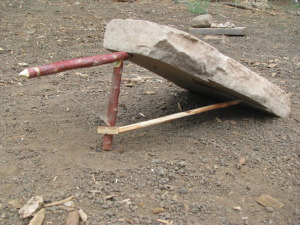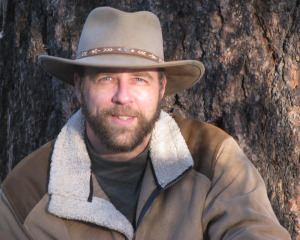The Modern Hunter-Gatherer
by Tony Nester
A Book Review by Brandon Jacobs

The Modern Hunter-Gatherer
The subject of hunter-gatherer is an interest for many people, including myself. The idea of using the land for most or more of one’s resources is very intriguing. There are many different regions, ways of life, ways of thinking, and just sheer differences in ways of doing things. Although the aforementioned is true, there are many concepts and approaches to harvesting from the land that will cross over to almost any area. Tony Nester does a good job of creating this connection in his book. Albeit not an end all wilderness guide to living, as no book could be so comprehensive in all areas, it covers the main components to using the land for one’s own benefit.
During the first few pages one learns that this isn’t regurgitated material, but the author has real life experience in what he is talking about. He gives some information about growing up and the time he spent outdoors. This in its own is great but what catches the attention of the reader is his mindset about Mother Nature. Throughout the book he mentions things like, “don’t take more than you need”, “be cautious not to denude your resources,” and “respect the life you are taking.” To me this speaks volumes about where and how this material came about. It’s a tried and true method to take what you need and ensure that one will have future resources. This is not a “survival” do anything to get out type of book, instead it’s how to collect and harvest things a person needs to meet their needs. This is an important aspect to anyone who is serious about making a living with nature.
The book starts out by listing four requirements one needs to be a modern hunter gatherer. He describes in some detail about the definition of each but leaves the end open for the reader to fill in the rest based on their area and skill set. As the book progresses he states some of the challenges that come from living off the land; again, he’s making the reader think about their own environment and the challenges they could face. “The land is the ultimate teacher.” Stressing that fact that although much information can be obtained from books, get out and observe, learn, and respect that land you call home. Throughout the book he gives first hand examples of the lessons he’s learned and why he is taking the approach he does. It is mentioned several times about doing research into the archeological history of your area. This gives the reader a firsthand place to start. People before us had the land figured out so there is no reason to reinvent the wheel. Some of the book is specific to Tony’s area but one can quickly pick up similar plants, animals, and methods that would transfer to their area. He breaks down one calendar year calling out when to harvest certain plants, hunt certain game, and refine one’s skills. Again, these skills are transferable into most areas.
 Moving through the chapters he covers firearms, ammo, bows, slingshots, spears, and even rabbit sticks. Practice, practice, practice; learn your weapon and have it become an extension of your body. Obviously hunting requires one to be in the outdoors for an extended period of time so clothing and survival gear come into play in his book. This chapter is filled with tips, tricks, and very good advice. Coinciding with hunting, trapping is covered in a practical and common sense way. “…carving traps does not make you into a trapper…” The author’s experience is highlighted again when he is not showing complex and time consuming traps. Instead he tells of the importance of using simplistic traps in greater quantities. The book covers a few useful traps and snares, giving the reader some very good information about how to set them and what to look for when setting them. Of course obtaining an animal supplies more than just food for the group or individual. Tony covers different uses for different parts of animals. Fishing is done with the same format as hunting and trapping. He goes through his tackle, methods, and cooking options once the fish is caught. He goes on to give great tips and tricks to catching them.
Moving through the chapters he covers firearms, ammo, bows, slingshots, spears, and even rabbit sticks. Practice, practice, practice; learn your weapon and have it become an extension of your body. Obviously hunting requires one to be in the outdoors for an extended period of time so clothing and survival gear come into play in his book. This chapter is filled with tips, tricks, and very good advice. Coinciding with hunting, trapping is covered in a practical and common sense way. “…carving traps does not make you into a trapper…” The author’s experience is highlighted again when he is not showing complex and time consuming traps. Instead he tells of the importance of using simplistic traps in greater quantities. The book covers a few useful traps and snares, giving the reader some very good information about how to set them and what to look for when setting them. Of course obtaining an animal supplies more than just food for the group or individual. Tony covers different uses for different parts of animals. Fishing is done with the same format as hunting and trapping. He goes through his tackle, methods, and cooking options once the fish is caught. He goes on to give great tips and tricks to catching them.
Lastly, and perhaps the most difficult subjects to cover are edible plants and insects. Recognizing that there are thousands of plants in different areas, he covers only a few of the most prominent in North America. Not an easy subject to cover but he does it very well without trying to cover the entire spectrum of the never-ending subject of edible and medicinal plants. By knowing and utilizing a few plants one can make their time in the woods long lasting. He gives the reader useful information about the amount of research it takes to become familiar with plants and goes on to give suggestions on where to get more information in a specific area.
 If you’re looking for a field guide that covers every trap, plant, and method of food procurement; find another book.
If you’re looking for a field guide that covers every trap, plant, and method of food procurement; find another book.
If you’re looking for a down-to-earth real life comprehensive book to add to an existing knowledge or looking for a way to get started, this is a book for you.
Go get the book and tell Tony we sent ya.



4 Responses to Modern Hunter-Gatherer